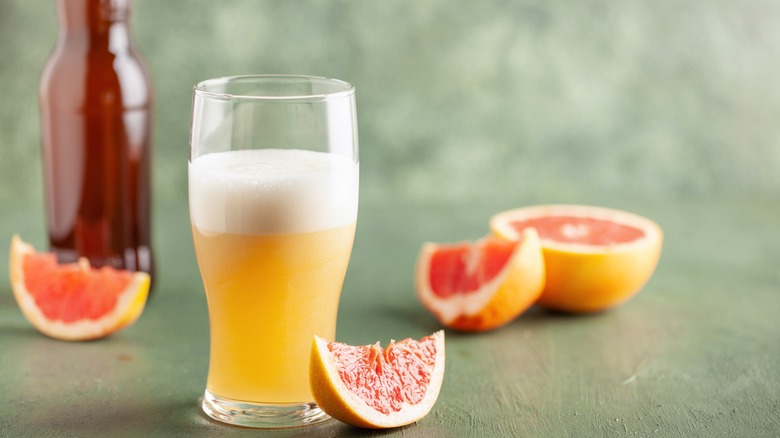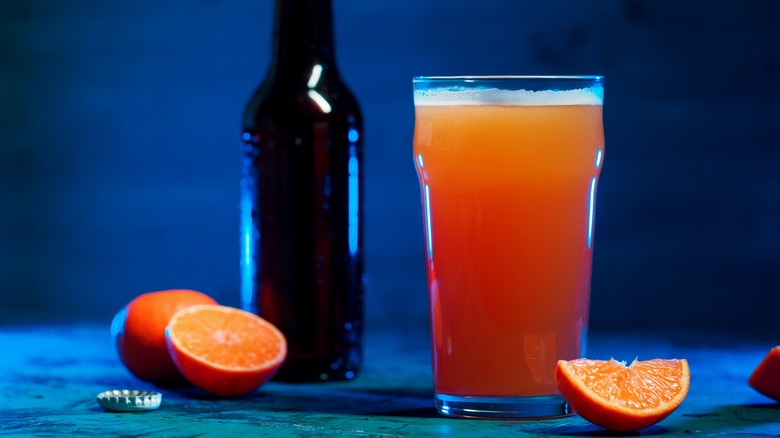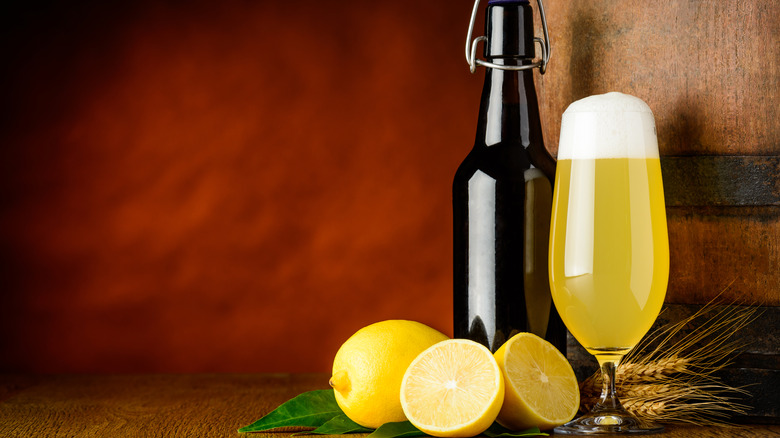What Makes A Shandy Beer Different From A Radler?
As Charles Dickens remarked in his 1853 novel, The Adventures of Mr. Verdant Green, there is one beverage that is the ideal "alliance between beer and pop." Although he was referring specifically to a shandy, anyone who has sampled a radler might wonder if more than one drink fits the author's description. It's a tale of two brews — closely related in their formulas, but miles apart in their origin stories.
Born in the United Kingdom and enjoyed around the world, shandy typically involves a one to one ratio of beer to a non-alcoholic mix-in like soda or juice. On the other hand, radler, a German creation, has a slightly narrower definition, with the same fifty-fifty combination of beer and a mixer, but the mixer is almost always citrus-forward. Both drinks are relatively similar to a beer spritz (sans the liquor) – like spritzes, shandies and radlers are refreshing and relatively low in alcohol. Plus, if you find yourself with a pack of beer that doesn't taste great on its own, mixing up a homemade shandy or radler is a simple method to make cheap beer taste better.
Shandy is short for shandygaff
Historians and linguists may not know what the word shandygaff translates to, but they agree that the drink dates back to 1850s Britain, and is the root word for its abbreviated successor, shandy. The drink's history is also murky, but is thought to have been conceived as a low-alcohol option made from beer and ginger beer that could quench the thirst of pub-goers after a long day's work, without getting them too tipsy.
The shandies of today aren't limited to just ginger ale. You'll often find them made with lemonade, sparkling lemonade, lemon-lime soda, and even apple cider or fruit juice. Light beers like blonde ale, pilsner, and lager are used as the base of this drink, but carbonation is key. A lightly-carbonated or uncarbonated beer just won't be as refreshing.
Aside from made-to-order shandies, large breweries and craft operations alike offer ready-to-drink options. One of the best-known is Leinenkugel's Summer Shandy, but for those who want to branch out, the UFO Big Squeeze Shandy and Short's Brewing Company's Soft Parade Shandy introduce a range of citrus and fruit flavors.
Radler is another word for cyclist
The radler's name gives a nod to its supposed origin story. As legend has it, Franz Xaver Kugler, a German tavern keeper, came up with the drink in the 1920s to quench the thirst of weary cyclists that frequented his tavern from a nearby biking route. It's unclear if the cyclists are responsible for this next part, but some say Kugler created the drink when he ran out of beer and needed to cut it with something, which happened to be a surplus of lemonade. Either way, the name stuck, and the result was a drink not so dissimilar to a British shandy with its light beer base, except for its insistence on citrus mix-ins like lemon soda, grapefruit juice, and lemonade.
Today, radlers are enjoyed in Germany and beyond, with brewers pushing the boundaries of the citrusy drink with flavors like raspberry, peach, and ginger. Those looking for a solid radler option can't go wrong with a classic Stiegl Radler or an icy cold can of Braxton Brewing's Scooter Blood Orange Radler.
While similar in concept, both shandies and radlers highlight an appreciation for leisurely, flavorful drinking experiences that can last through a summer afternoon (and beyond). Whether opting for a British shandy or a German radler, these beer cocktails promise refreshment with every sip.


